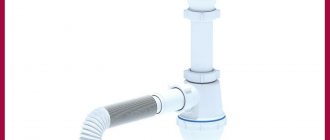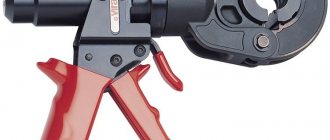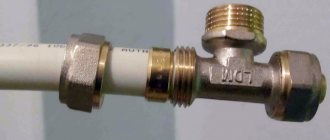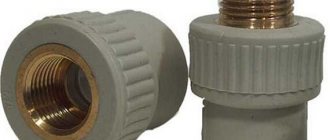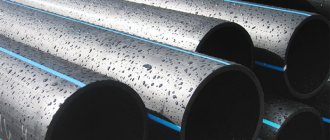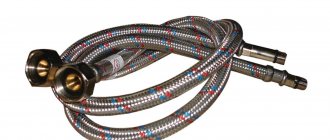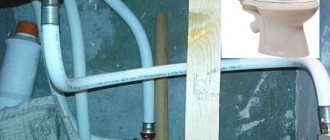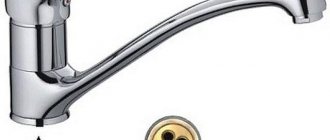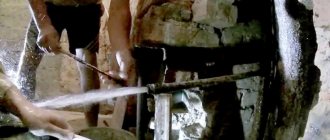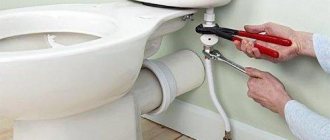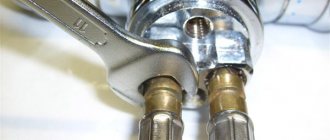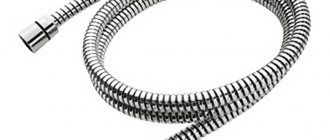Flexible water line
A flexible water line is more preferable for the vast majority of people. It is small in size, easy to use and easy to install.
Flexible hose is an elastic, strong hose. Its length usually ranges from 30 cm to 5 meters. At the ends of the hose there are fasteners with a seal, which is a special rubber ring. Most modern manufacturers of plumbing products use this particular liner option for their equipment. This is justified by a number of undoubted advantages.
How much does it cost to replace a kitchen faucet?
When choosing the optimal model, the following points are taken into account:
- dimensions and depth of the sink;
- the presence of free space in the sink between the bowl and the wall;
- dimensions and location of the mounting hole for the tap.
The most widely used types of kitchen faucets are:
- axle crane;
- single lever;
- electronic.
- Traditional axle-box cranes are simple in design and reliable. The main working element in them is the crane axle box, which can be easily replaced or repaired if necessary. Accordingly, the problem of how to change the entire faucet in the kitchen does not arise. Crane axle boxes come in two types: ceramic and worm. Firstly, locking and adjusting the flow of water is done by rotating ceramic plates with a hole relative to each other. Secondly, by raising and lowering the rod rotating along the thread.
- A single lever kitchen faucet is more convenient to use because it has one single control. The main element in it is a cartridge, very similar in design to an axle-box faucet, but it controls two water flows at once. The housings of single-lever models can be either stationary or rotating relative to the installation axis. There are also ball ones, in which the water is blocked by a rotating ball with holes.
- Electronic options allow you to provide water at a constant temperature. Some models can turn on water using a contactless sensor. However, structurally they are very complex devices, which inevitably increases their cost. Power supply can be supplied from the mains or from batteries. The height of the spout is selected taking into account the characteristics of the sink bowl. For shallow models, models with a low spout, which reduces splashing, are better suited. In a kitchen, installation is most often done either directly on the sink bowl or on the countertop.
The total cost of replacement will consist of the costs of the faucet itself, consumables and installation work. At the end of 2018:
- The minimum price for a kitchen faucet is 400 rubles. The maximum is from several thousand.
- Which mixer is better is up to the owner to decide, but more expensive models will always be more reliable. A coarse filter costs from 120 rubles.
- In most cases, you won’t have to spend money on eyeliner, since it is usually included in the kit. If it is not there or is not long enough, then you will have to pay 150 rubles for the hoses.
- Calling a plumber will cost from 400 rubles. If you install it yourself, the work will be free.
To prevent the problem of “how to choose a kitchen faucet” from bothering you too often, you just need to promptly replace worn-out gaskets, cartridges and aerators. In addition, it is periodically necessary to clean the coarse filter and monitor the condition of the mesh inside it.
We have selected eight more useful articles for you, see below.
- Copper pipes and fittings for water supply - quality guarantee for 200 years!
- How to turn on the boiler correctly for the first time
- How to install water pipes in a private house with your own hands
- Which pipes are best to choose for water supply in a private house?
- PVC pipes and fittings for water supply: product descriptions, current prices and installation
- Everything about connecting to the city water supply network in a private house: documentation, work, prices, sample documents.
- How to weld polypropylene pipes: instructions and tools
- If the water supply is frozen, how to defrost it? Learn more about the reasons and methods of defrosting.
The main advantages of flexible hoses:
- This is their mobility, compared to rigid structures.
- You can also highlight their convenience when installing in hard-to-reach places. In addition, installation of flexible hoses is easy in places with limited space, without compromising its integrity and reliability. Whereas the installation of metal pipes is very complex, inconvenient and time-consuming.
- Almost complete tightness of the structure due to manufacturing from the best quality materials
- Even a beginner who does not have special equipment or special skills can cope with the installation or dismantling of the structure
- Vibration resistance
- If certain rules are observed, flexible water supply has a long service life.
- Low exposure to high temperatures
The flexible type of design is convenient when installing in a large network of pipes, as well as other plumbing fixtures. The same cannot be said about tough types.
How to replace eyeliner
When replacement is necessary
It is necessary to change the hose if:
- The flexible line broke. Breakage of the braid or rupture of the internal hose will lead to the formation of a leak and, as a result, flooding of the room. The causes of leakage may be high pressure in the system or mechanical impact;
Loss of tightness of the connecting hose
- A flexible hose leak was detected at the junction with the mixer or water pipe. The causes of leakage may be natural wear of the gasket or a crack in the fitting (nut).
Leak at the hose connection
Flexible line replacement process
To install a flexible water supply to connect a mixer, you must:
- turn off the water supply. This can be done using a tap installed in the apartment;
- open the mixer taps to drain the remaining liquid;
- Using an adjustable wrench or a wrench corresponding to the diameter of the union nut, unscrew the hose from the water pipe. If the connection point is rusty and the hose does not unscrew, then you should not make any effort to remove the liner. In this case, a solvent or WD 40 liquid is applied to the rust, which removes plaque;
Disconnecting a flexible hose from a water pipe
To avoid flooding with water remaining in the hose, it is recommended to place a container under the wiring connections.
- remove the mixer.
To do this, it is necessary to loosen the nuts securing the device; Places for fixing the mixer to the plumbing equipment
- disconnect the hoses from the mixer with an adjustable wrench;
- connect new connecting hoses to the mixer and install the device in its original place. If the fastening on the hose does not correspond to the connector on the faucets, then additional adapters are installed. When installing the adapter, it is important to take care of the tightness of the connection, which is made using FUM tape or linen thread;
Installing flexible hoses on the mixer
- Attach the supply hoses to the outlet of the water pipe.
It is necessary to screw the hoses to the mixer and outlet without much force, which can lead to the formation of a crack in the union nut or fitting. There is no need to use additional means to seal the connection, since the liner already contains built-in gaskets.
- When you turn on the water for the first time, it is recommended to check the flexible hose and connection points for leaks. The average inspection time is 20 – 30 minutes.
The process of replacing connecting hoses is presented in the video.
Replacing flexible hoses yourself is not a problem. The main thing is to choose the right hose that meets all the parameters.
Here's a problem. I bought far from the cheapest faucet for a washbasin, unpacked it, took out the included flexible hoses in the kit with the usual gesture and threw it away (the short ones), took out the longer ones purchased in advance, took the key for 11 and... it broke off abruptly. I’ve done this a hundred times before, everything was fine, but this time it turned out that the holes for screwing in these hoses are STRONGLY RECOVERED into the mixer body and it’s not possible to get a wrench to screw them in. I took the original hoses out of the trash can - they screw in even worse, because... They don’t even have a height difference for twisting. I tightened it with my HANDS as best I could, connected it to the valves, turned it on, it doesn’t seem to be leaking, but I still want to tighten it more securely, otherwise, if it leaks, I’ll get bored of disassembling the entire structure of the washbasin. And now there are actually two questions. 1) are there any special ones in nature? wrenches for screwing hoses into such clever faucets? 2) Why the hell make faucets like this, why not make these holes at the same level as the faucet mount with the washbasin (a rhetorical question, of course).
The service life of flexible hoses directly depends on the correct installation.
Before installation, it is necessary to carry out a visual inspection of the liner
for the quality of the sleeve crimp, the quality of the end fittings, the presence of a gasket, damage to the thread, integrity of the braid and other defects that may occur during storage and transportation.
Before installation, check the reliability of the sleeve crimp and the integrity of the liner braid
Poor quality connections can fail even with normal water pressure. Access to the end fittings must be free for installation and inspection.
It is necessary to use eyeliner of sufficient length. It is not allowed to increase the length of a flexible liner using another liner.
It is prohibited to subject the liner to mechanical stress, twisting, stretching, or breaks.
during storage, transportation and installation.
Twisting of the liner along the longitudinal axis is not allowed.
Install the liner with a bend radius of at least 70 mm.
If necessary, use a liner with an elbow fitting.
The minimum bending radius must be at least 70 mm
It is forbidden to install the liner under tension.
It is not allowed to install the liner under pressure
Do not overtighten connections!
The end fittings should be tightened with a force of no more than 0.4 Nm. This force corresponds if the union nuts are screwed on manually and then tightened a quarter turn with a wrench.
When installing the end fittings of the liner, it is prohibited to use plumbing flax or other sealants that can expand in a humid environment.
Upon completion of installation, make sure there are no water leaks. Slowly turn on the water, carefully turning the water tap to the fully open position. If drops appear at the joints, the union nuts must be carefully tightened. After 30 min. After installation, it is necessary to visually inspect the connections and make sure there are no leaks.
Prohibited:
• operation of the liner at sub-zero temperatures and near open fire. • hang rags, sponges and other cleaning equipment on the liner, store chemicals near the liner. • install flexible hoses through ceilings.
Every 6 months it is recommended to do a visual inspection of the liner and check the tightness of the end fittings.
A flexible hose with an external stainless steel braid allows the hose to withstand high pressure (up to 10 atmospheres) and is resistant to condensation. The service life of such products is up to 10 years. The recommended replacement period is 5 years.
Disadvantages of flexible structures.
Despite all the advantages, this type of eyeliner also has its bad sides. They are revealed already during use:
- Excessive twisting, tension and bending can damage the integrity of the braid, which will inevitably lead to a reduction in service life.
- Installation in close proximity to an open flame source is prohibited
- Fasteners gradually corrode under the influence of water and time. Which will eventually lead to the repair of the faucet or other expensive fittings.
- Some types of flexible structures do not respond well to exposure to too high temperatures (water close to boiling)
Life hack: how to connect a hose to a tap
Using scissors, cut off 1/3 of the top of the ball.
Remove the fitting from the hose and put the cut ball on it.
Place the hose close to the drain hole of the faucet.
And pull the ball from the hose onto the tap.
We wrap this entire connection tightly with tape.
That's all! No water will leak. The adhesive tape holds it securely, and the ball material tightly seals the micro-cracks.
Now you can easily water your plot.
Or fill the pool.
This connection is suitable for any hose and any tap.
Holds full water pressure perfectly without leaking.
To replace the crane with a new one, you must first dismantle the old equipment.
This requires a number of operations.
- The water supply to the sink is shut off.
- The taps are opened so that the remaining water in the pipes can flow freely into the sink.
- If the sink is a surface-mounted type, then it is detached from the cabinet.
- The liner is disconnected from the water pipe. At this stage, it is advisable to use a basin to drain the remaining water.
- The siphon is unscrewed.
- The sink is raised and installed on the cabinet in such a way as to provide free access to the place where the device is attached.
- Flexible connections are disconnected.
- If there is a watering can, then it is also disconnected.
- The fastener is unscrewed.
Then you should hold the spout with one hand, and with the other unscrew the threaded mounting pin and remove the old tap.
Installing such a tap allows you to cut off the tap from the water supply for repair or replacement. However, in practice this does not always make sense.
As plumbing experts recommend, first you need to study the water distribution diagram throughout the apartment. If there is already a ball valve immediately after the outlet from the riser, then there is no need to duplicate it. If desired, you can install a valve or reducer that will help limit the water pressure in the tap.
Flexible hose covered with reinforced braid.
It is a hose, very elastic and covered with braiding made of various materials. Fittings are attached to the ends. A fitting is attached to one end, and a union nut with a certain external thread diameter is attached to the other.
One of the advantages is the low price. That is why this type of flexible water line is very often chosen by buyers. The hose manufacturing technology is not too complicated. But nevertheless, this type of eyeliner has a very complex structure. The base is rubber, rubber or reinforced cross-linked polyethylene. The hose is braided with wire thread.
When braiding it is possible to use a variety of materials:
- Stainless steel is the most popular winding material. It is characterized by the most average parameters. It exhibits its properties well at +95 degrees in liquid 10 atm. pressure. Reliable operation is ensured for 10 years. Ideal for connecting the water supply to the toilet cistern.
- Nylon performs better than stainless steel. Operating temperature up to +110 degrees. The working pressure cannot be more than 20 atm. pressure. Stable work for more than 15 years.
- Aluminum is a less stable material for braid production. The temperature of the liquid must not exceed a certain temperature. This is +80 degrees for stable operation of the braid. Pressure no more than 5 atmospheres. The service life of such a braid is about 5 years. Disadvantages include increased susceptibility to corrosion. Products with aluminum braiding should be used in environments with low humidity.
Do-it-yourself methods for connecting hoses
If you do not want to buy modern plastic devices for connecting products, you can use one of the proven traditional methods: through an inexpensive adapter, through a piece of pipe and through a fitting (if the hose is connected to a pipe).
Today, hose fittings for any pipe and any hose are available for sale, and they are quite cheap.
For polypropylene pipes, you can use similar solutions with external threads, screwing them into the fitting. The only point that you need to pay attention to is the thickness and length of the fitting. You can grab the hose using a special clamp, or you can use a wire twist. There is absolutely no difference in the quality of the connection, but the cost is reduced several times when compared with factory-made plastic connectors.
It’s a common thing when there are many different hoses lying around in a garden plot or vegetable garden. Pieces of products can be connected using a piece of pipe of a suitable size and used on the farm. This is done very simply: hoses are put on a length of about 10 cm on both sides and grabbed, as mentioned earlier, with wire or clamps.
Drain hose connection diagram.
The adapter-connector, like the pipe mentioned in the previous example, connects both pieces of the hose, only it has special notches at the ends that make the process of joining the hose easier and more convenient if the diameters of the connections do not quite fit each other.
You can make your own hose connector from a coupling and polypropylene pieces.
When assembled, such a homemade connector looks quite good and holds the hoses at ¾ length. A tee for connecting hoses can be made in a similar way. The closest store-bought analogue is a coupling (products are clamped using a union nut and petals on both sides).
For a high-quality and reliable connection of hoses, prepare the necessary tools and materials, namely:
- pipe cutters;
- Workbench;
- couplings;
- adapters;
- nuts;
- clamps;
- wire;
- spanners.
Bellows liner for water.
It consists of flexible bellows tubes with design features.
The advantages include:
- Reliability in operation
- Much longer service life compared to reinforced structures.
- The bellows liner is also very flexible. The design consists of assembled stainless steel rings of different diameters.
This eyeliner comes in two types:
- The first type is folding. It has the ability to stretch in the ranges specified by the manufacturer: from 200 to 355 mm. and from 140 to 250 mm. To avoid reducing service life, care should be taken when stretching.
- The second type is a fixed bellows connection for water supply. Does not stretch and has a certain length. Minimum length 10 cm. Maximum length 80 cm. Manufacturing step 10 cm.
The main negative property of such a liner is the hum that occurs when water flows to many products at once. For example, water is supplied to several plumbing units at once. To avoid this drawback, you should purchase an insulated bellows liner. Or use special anti-vibration types of liners that absorb sound.
Use Cases
The issue of redirecting water flow becomes relevant when intending to water a summer cottage, facilitate cleaning of a large area, carry out repairs in the house, ventilate and drain boiling water from the heating system. Adapter fittings are the best solution to the problem. They can be simple, like hose attachments for a faucet or valve, but complicated designs are also not uncommon in this group.
Accessory set for multifunctional plug connection with fittings and watering can
Irrigation devices
The classification of hose products is based on differences in diameter and material. Gardeners consider an internal cross-section of 13 mm to be the most convenient for connecting to a water supply for the purpose of watering beds. Closer to it in popularity in the gardening “line” are diameters of 18 and 25 mm.
A simple plastic splitter for a watering hose is a democratic solution for summer residents
The materials used to make a hose for a faucet for the kitchen of a country house can be:
- technical rubber;
- plastic;
- polyvinyl chloride;
- nylon.
Owners of apartments and dachas recognized rubber as more reliable and durable than others: it calmly “endures” temperature fluctuations, is not afraid of kinks and is quite durable. Plastic breaks and becomes covered with plaque; nylon becomes deformed during frequent transitions from a cold to a hot environment. The option with a reinforced PVC watering sleeve, comfortable and wear-resistant, is very good, but a bit expensive for many. The list of elements of the irrigation system will necessarily include:
- fitting (threaded or without thread) with connector;
- repair coupling with one or a pair of adapters.
If there are several directions of irrigation, a combination of a hose splitter with a tap will be useful (this flow-distributing part is also called an adapter). The adapter block block will allow you not only to wash your hands, but also to expand the water supply circuit through water filters. It will also provide the ability to quickly and easily connect the washing machine to a ready-made household communications unit.
The branching block allows you to connect 4 hoses to the system at once
Standard adapter with 3/4 watering tap – optimal connection option
Gas and water fittings
The arrangement of the kitchen and bathroom area today is rarely complete without flexible polymer snake hoses braided with metal. Docking is carried out through a sealed threaded connection of the hose with the tap and other plumbing accessories. The markings of the hoses and tubes are different: the blue stripe is for a cold stream, the red stripe is for a heated stream. You should buy them with a length reserve. The purchase and installation of gas equipment is a task of increased responsibility, since breakdowns and leaks in such an important communication chain are not just unpleasant, but dangerous. Instead of a short-lived rubber sleeve, it is better to immediately purchase a heat-resistant polymer sleeve in a steel braid: it is stronger and complies with GOST. The gas-carrying set of hoses and taps with watering cans for gas are marked in yellow.
The universal faucet adapter is equipped with a locking handle and a screen divider
How to choose flexible eyeliner.
When purchasing flexible eyeliner, it is better to pay attention to products from well-known brands. Since when buying little-known eyeliners, you can encounter a number of problems.
When choosing a flexible eyeliner among Russian manufacturers, it is better to choose eyeliners from the companies Monolit, Flexiline, and Akvatekhnika. Among the foreign ones we can highlight products from Tucai, Mateu, Uni-Fitt. These foreign companies have the necessary guarantees and the necessary sanitary permits.
- The temperature and pressure characteristics must exactly match the parameters specified in the eyeliner manufacturer's instructions and on the label.
- Understand under what conditions the liner will be used and only then choose the braid material. This is especially important when connecting a washing machine or faucets.
- Estimate the weight of the selected eyeliner. If the product is too light, then most likely low quality materials were used in its production. Or aluminum was used in the production process.
- The eyeliner should be completely free of unpleasant odors. If they are present, there is a significant probability that technical rubber was used during the production process, which is very dangerous when exposed to it.
- Check the elasticity of the selected eyeliner. Low elasticity means that the tubes are likely to burst quickly during installation or when the product is already in use.
- Carefully inspect the fittings. They must be absolutely free of defects. The best materials for their manufacture are nickel-plated brass and stainless steel. Aluminum fittings should not be used. Also, plastic fittings are not recommended for use.
- Check the correspondence of the internal or external threads of the liner with the holes of the connected product. Thread diameter ranges from 0.5 to 1.5 inches.
- The diameter of the liner for sinks, shower stalls and sinks should be more than 10 mm.
- The ideal length for the liner is the one when no sagging or tension is formed after it is connected to the system.
Flexible connection for the mixer: how not to get confused when choosing
Flexible connection to the mixer is one of the most common elements used for the installation of plumbing fixtures. There are a huge number of different flexible hoses on the market, which makes choosing the right part difficult.
We would like to help you understand the ins and outs of liners, especially if you intend to install the faucet yourself.
Purpose
Connectors made of flexible material are used to connect various plumbing fixtures to water pipes.
By and large, the scope of application of these products is much wider; they are actually seen in arbitrary pipelines:
- gas,
- technical,
- automobile, etc.
But within the framework of our article, we are looking at only the plumbing segment of their application.
So, a flexible lead is used to connect the following devices:
- Taps and mixers;
- Boilers;
- Shower cabins;
- Washing cars;
- Dishwashers;
- Pumps and pumping stations;
- Gas water heaters and boilers;
- Toilets, bidets, toilet installations.
Why has this type of pipe become so widespread? Everything is quite simple: using a flexible hose, it is possible to connect any device without connecting steel or plastic pipes exactly to the connection point, since for this you often have to not only cut and weld metal, but also tap the walls.
Along with this, each inaccuracy will lead to the fact that the work will need to be redone or the device moved, which is very undesirable.
In addition, quite often the faucet is connected in hard-to-reach areas, especially in small bathrooms with a clutter of pipes and various devices. The use of a flexible supply eliminates all such troubles, since it can be laid virtually anywhere and along the most winding route.
At the repair stage, you just need to remove the water sockets from the wall or floor near the intended installation location of the washbasin. After this, you match the length of the liner and connect the mixer to the pipes.
Note! Hoses are prohibited from being used as a replacement for main and distribution pipes. In addition, it is not advisable to use them in heating systems to connect radiators.
Device and materials
The flexible inlet for the mixer is designed quite simply - it is a rubber tube into which fitting bushings are inserted on both sides. From above, the connection between the pipe and the bushing is pressed with steel crimp. In addition, the product has external reinforcement in the form of a braid of iron or polymer wire.
Couplings with internal threads (sleeve nuts) or fittings with external threads are used as fittings.
- Much more often, a nut-fitting assembly (designated g/w) is used to connect the mixer.
- But on sale it is possible to find a nut-nut version (g/g).
- From time to time, fitting-fitting (w/w).
The most common common nut size is ? inches, fitting - M10.
You often see an option with a 1:2 inch fitting; in addition, you come across a 3:8 inch nut (you have to use an adapter fitting to connect it). Models with a long fitting are common and popular among plumbers, since it is more ergonomic to connect them to the mixer from the bottom of the sink.
In high-quality hose models, the fittings are made of plumbing bronze (Cu Zn39 Pb3). It can be pure or nickel plated. The crimp sleeve is made of stainless steel (GOST 08Х18Н10 or AISI 304).
Note! In modern construction stores, you often see products with fittings made of an alloy of silicon and aluminum (silumin). This is an unacceptable option, which can be destroyed even at the installation stage; therefore, it should not be taken.
It is possible to find out what the nut and fitting are made of simply: if you scratch nickel-plated bronze, the bottom of the groove will be yellow. Silumin will remain monochromatic. In addition, aluminum alloy is much lighter than brass.
The hose itself must be made of ethylpropylene rubber (EPDM), a non-toxic rubber approved for transporting drinking water. This material is elastic and can withstand peak pressures of up to 50 atmospheres.
Here, when choosing, you need to smell the product: if it emits a characteristic unpleasant smell of synthetics, it means that the hose is made of technical toxic rubber, which, moreover, easily breaks and crumbles when bent strongly.
The union nut must be equipped with a sealing gasket, and the fitting must be equipped with one or more rings. These gaskets and rings must also be made of ethylpropylene rubber.
The outer braid in conventional products is made of stainless steel or polymer fiber. Such liners last from 8 to 20 years and can withstand operating pressure of 10 – 20 atmospheres.
But on sale there are models with aluminum braiding, and from time to time the reinforcement is made of simple galvanized steel.
Note! Aluminum braiding will last a maximum of 2 - 3 years, steel braiding can rot in just a few days. As a result, the hose may burst, and petty savings on the quality of the liner will cause you a lot of significant trouble.
The length of the eyeliners in most cases ranges from 30 to 200 cm, but if you are thirsty, you can find virtually any size. In addition, flexible connections sometimes include bellows - tubes made of corrugated stainless steel. They are more durable and reliable, but their price is higher.
Note! There are stripes on the braid. light blue - for cold water, red - for warm water, light blue with red - for universal water, yellow - for gas. Low-quality products may not have similar markings.
Installation rules
Despite the fact that the installation instructions for the products are incredibly simple, when connecting them you must follow certain rules:
- Before connecting, be sure to inspect the product for defects, breaks in the braid, presence of sealing gaskets and rings;
- When choosing a hose, select a length so that it is not stretched , and the turning radius is at least 5 - 6 of its outer diameters;
- During installation, bends are not allowed ; instead, it is better to make rings;
- It is not allowed to twist the tube along the longitudinal axis;
- The threaded connection of the nut and fitting does not lack sealing with tow or FUM tape ; its role is played by rubber rings and gaskets;
- The nut is tightened by hand until it stops , then tightened with a wrench half a turn, to a maximum of 270 degrees. Over-tightening risks cutting through the gasket, which leads to leaks.
Note! Receive only high-quality products made from materials that meet the standards. Saving can be very expensive.
Conclusion
The use of flexible connections allows you to connect various plumbing fixtures to the water supply. When installing faucets, they are often completely indispensable, so choosing the appropriate model should be taken seriously, which the video in this article will help you with.
Source: https://uchebniksantehnika.ru/smesiteli/gibkaia-podvodka-dlia-smesitelia-kak-ne-zaputatsia-pri-vybore.html
DIY installation instructions for flexible hoses.
Even a beginner will be able to cope with connecting flexible hoses in a short time. You should know that hoses can be installed in the same way for used faucets. If you connect a mixer with a flexible hose, make sure that the hot and cold water are located correctly.
Connecting bellows and reinforced liners is the same.
- First, you need to ensure the integrity of the product after transportation.
- Turn off the hot and cold water supply taps to maintain safety precautions.
- You need a wrench or adjustable wrench that exactly matches the diameter of the union nut.
- It is necessary to place containers for the remaining water under the connections.
- When the hose is disconnected, you need to loosen the fixing nuts of the mixer and remove it.
- Then disconnect the liner.
- To install a new product, all steps are performed in reverse order.
There may be cases where the mixer and hose do not fit together. To do this, you should use special adapters.
The connections can be sealed with fumlente or flax.
Choice of eyeliner
If you need to replace the flexible hose, then first of all you need to choose the right hose to connect the mixer. When choosing, you need to rely on the following factors:
- purpose of the eyeliner. On sale you can find hoses for connecting cold and hot water, as well as universal products. The cold water liner is wrapped with blue thread. For hot water - red thread. The universal eyeliner has inclusions of both blue and red threads;
Connection suitable for connecting both cold and hot water
To avoid misunderstandings, experts recommend using a universal connection for connecting the mixer.
- hose parameters. When selecting parameters, it is necessary to determine the type of connection of the line to the mixer and water pipe (nut, fitting, etc.), as well as the type and size of the thread. Threads can be internal or external. Thread sizes range from ½” to 1 ½”. At the next stage, the length of the hose is selected. To make the connection as reliable as possible, it is necessary to eliminate the possibility of tension on the hose. To do this, you need to choose a device whose length is slightly greater than the distance from the mixer to drain the pipe;
Selection of eyeliner according to connection type
- material for making fittings and nuts. Brass is more reliable and durable. Connecting elements can also be made of aluminum (over time, the material becomes rusty and becomes unusable) or plastic (highly susceptible to mechanical stress);
- the hose must be sufficiently elastic. If, when holding the hose by one end, the hose assumes a hanging position, then this indicator is normal. If the hose takes a horizontal position, then the elasticity of the product is small;
- there should be no visible damage on the winding, nuts and fittings, which will lead to a reduction in the service life of the product.
Based on the factors presented, each user can independently select the most suitable and durable product.
A few rules when installing flexible hoses:
- The hose must be straightened before installation. Kinks should be avoided
- Do not use excessive force when screwing the flexible connection
- Access to the installed product should be easy for inspection and maintenance. (period 6-12 months)
- It is better to make connections from similar materials. In the worst case, the development of electrochemical corrosion will be inevitable. It is possible to connect brass and copper parts.
The last stage of installation will be mandatory testing. The hot and cold water supply valves open. And then within half an hour the tightness and free flow of water in the installed product are checked. If moisture is detected at the joints, carefully tighten the nuts with a wrench again.
The last piece of advice should be noted that when leaving for a long time, you should turn off the hot and cold water supply valves to the water supply. Since any flexible liner is always subject to stress and can burst.
Types of eyeliners
Unlike bathroom faucets, which are hung on the wall above the bowl, kitchen varieties are mounted on the sink. In this regard, water is supplied to the faucet body using various types of connections.
Most modern faucets are of the cartridge type; there are two closely spaced threaded recesses inside their body to connect hoses.
A standard mixing connection has a fitting with an M10 external thread (diameter 10 mm along the thread crest) and one or two ring gaskets for screwing into the tap holes. Its internal diameter is standardized and approximately equal to 8 mm; for screwing to the body, the nipple design has a hexagon designed to use a 10 mm key.
On the other side of the hose there is an insert with a collar that holds a union nut with a standard 1/2 inch (15 mm) diameter. When screwed, the joint is sealed by a flat-shaped internal rubber gasket.
Rice. 5 Flexible braided liner - design and materials of manufacture
Flexible rubber braided
Liners made of thin-walled rubber with aluminum or stainless steel braiding are leaders in use in kitchen sinks. They are highly flexible and strong enough to last in hot and cold water supply systems for at least 5 years.
The inner tube of the hose can be made of ethylene propylene diene rubber (EPDM), cross-linked polyethylene (PEX).
The crimp sleeves, one of which acts as a fitting, and the second holds the union nut, are made of AISI 304 stainless steel (the sleeve for the nut can be made of brass). The American union nut is often made of chrome-plated brass.
Rice. 6 Design of multilayer liner
Polymer
Polymer eyeliners, the main material of which is polyvinyl chloride (PVC), are a rare guest on the domestic market. They are mainly used for installation of imported mixing devices from the world's leading manufacturers, if they are included in the package.
Multilayer
These are high-strength hoses that, in addition to the inner tube and braid, have an outer sheath made of polyethylene, nylon or other plastic.
Thanks to this, they are able to withstand pressure in the network up to 20 bar, which is several times higher than the maximum pressure of cold water in household communications, equal to 6 bar.
It is clear that the service life of such eyeliners is much higher than usual; it can reach up to 15 years.
Rice. 7 Polymer and bellows hoses
Bellows
Flexible hoses made of corrugated stainless steel can withstand significant temperature loads and pressure in the system, reaching up to 20 bar (depending on the wall thickness). Bellows liners have a long service life, reaching up to 25 years.
Corrugated pipes do not change their cross-section when bent, they dampen vibrations and water hammer in the system well. Their disadvantages include insufficiently high flexibility, due to which the bending radius of the sleeve is larger than that of polymer products. In addition, the rigid shell of bellows pipelines often does not withstand constant bending and movement.
However, operation under the kitchen sink does not involve any movement of the corrugated pipe, so it can be used for a very long time.
Hard
Rigid eyeliners are not found on sale as often as their flexible counterparts. They are made from metals: stainless steel, brass, copper.
Some experts make them with their own hands, assembling them from pipe sections and fittings by soldering or welding.
Install the hose on the faucet
Flexible hoses for the mixer are a supply that makes it possible to connect the tap to the water supply. For this reason, the tightness of the connection and durability depend on their quality. The material from the construction portal “Remontik” will discuss what flexible hoses are, what you should pay attention to when choosing, and how to use them to connect the mixer.
Kitchen faucet installation
Assembly
First of all, you should assemble the device itself. those. screw on the spout, aerator, install handles, etc. The sequence of operations may vary for different models and different manufacturers. You can find out more details and features in the instructions supplied with each device. When choosing a faucet for the kitchen, it is advisable to make sure that this document is clear.
In this case, fabric linings will be an excellent solution for installing a faucet in the kitchen without damaging it.
Next, flexible connections are connected. They should be tightened carefully so as not to damage the attachment of the flexible part to the threaded fitting.
The length of the fittings can be either the same for both connections or different. Many manufacturers use the second option to facilitate installation work. The order of further actions will depend on where the faucet is attached: directly to the sink or to the countertop.
Installation on the sink
There are two ways to attach a two-valve faucet to a sink:
- Mixer with fasteners;
- 2 flexible eyeliners;
- rags;
- masking tape;
- adjustable wrench.
Turn off the water
Faucets that supplied hot and cold water separately are practically a thing of the past. They have been replaced by faucets that mix cold and hot water by changing the location of the device handle. In our article we will talk about the nuances of installing a faucet on a sink.
The mixer is an integral part of the plumbing system
When purchasing a mixer, you should pay attention to:
- the material from which it is made;
- sealing parts;
- spout type
High-quality faucets are made from bronze or brass. Their main difference is the yellow spout neck of the device. If the neck is gray, then the mixer is made of silumin. This material wears out quickly due to corrosion.
The sealing elements must be rubber. The mixer kit must include a split spout spacer ring. Some unscrupulous sellers claim that it does not need to be installed. But that's not true. The absence of a spacer ring will cause the mixer to become loose and leak.
As for the type of spout, it is better to purchase a faucet with a swivel spout for sinks. This is explained by the fact that models whose spout does not turn are inconvenient to use. Often the stream of water hits the edge of the sink or flows down its edge. And you won’t be able to wash your face properly when water is pouring into one point.
Mixer assembly
The main elements of a mixer for large sinks (made of stone or cast iron) are:
- 1-2 stud screws;
- a pressure plate having a rubber gasket;
- nuts
If the sink is made of light stainless steel (for example, a kitchen sink), then a plastic support plate is also used. It is attached between the shell body and between the rubber gasket of the pressure plate. The plastic plate will provide the mixer with a more rigid attachment to the sink.
Mixer assembly
The tightness of the lower nut is first checked. It must be done by hand along the entire thread. After tightening it, the faucet should not wobble on the sink. If this does not happen, then you were given a defective product.
A spacer ring is placed at the base of the spout. It should fit into the groove. The ring is quite tight and may not immediately fit into the hole. To install it in place, it should be squeezed with tweezers near the cut, and the lower part of the spout should be lifted slightly. The click of the ring means it is locked correctly.
A liner is provided to connect the mixer to the water pipe. It can be rigid (copper tubes with a diameter of 10 mm) or flexible (a metal braided hose equipped with a fitting or union nut). Flexible eyeliner is more convenient.
In order to properly connect the flexible hose to the mixer, you must adhere to the following requirements:
- It is forbidden to install the liner in a highly tensioned position.
- To prevent damage and leaks, the connecting elements are not tightened all the way.
- The eyeliner should be positioned in its natural state, without excessive twisting or kinking.
- The diameter of the liner should be 5-6 times less than the bending radius.
- To avoid premature corrosion, it is necessary to connect elements from compatible materials (for example, steel parts are joined to steel products, brass to brass or copper, etc.).
Despite the presence of rubber seals in the fitting, it is necessary to additionally use winding material, which will improve the sealing of the connections. The best solution would be to use sanitary flax and sealant.
Flexible connection to the mixer
Tightening the union nuts should not be accompanied by turning the connection. This process involves holding the crimp sleeve with pliers. When tightening the nuts, you should try to twist the line a little in the opposite direction.
After fixing the flexible hose, the mounting screws and bottom gasket are installed to seal the mixer. Having done this, you can begin installing the faucet on the sink. The pins are tightened. Depending on the type of construction, a screwdriver or wrench is used. In the second case, the nuts need to be locked.
Flexible hoses attached to the faucet are passed through holes in the sink. Sometimes you may encounter that two union nuts do not fit into the sink hole at the same time. It becomes impossible to lower two flexible hose tubes at once. In this case, one liner tube is passed into the sink, and the second is connected to the mixer through a hole.
The lower fastening of the mixer is being assembled. If the mixer is mounted on a sink with thin walls, then the design is complemented by a plastic support plate. The nuts located on the studs are tightened using an open-end wrench.
The nuts are tightened in such a way as to ensure reliable fastening of the mixer to the sink. It should not move when turning the spout or water handle. But you shouldn’t overdo it with tightening the nuts either, since you can damage the surface of the sink, tear off the nuts and threads on the studs, and also deform the pressure plate.
A completely logical question immediately arises: how can a flexible hose be connected to a water pipe, when tightening the fitting can be accompanied by simultaneous unscrewing of the hose from the mixer body? To avoid this, a liner is used, one of the fittings of which has a left-hand thread (usually it is screwed into the mixer body).
Particular attention is paid to the thread of the water pipe. If it is threaded on a thin or metal pipe that will rust, then a stainless steel protective tip is installed between the union nut and the thread.
Connecting the faucet to the plumbing system
The best solution is when, when connecting the liner to the pipe, the internal thread has a minimum length of within 1.5 cm. The thread should be located on a thick wall, and the elements are screwed in using a winding for sealing.
The correct assembly of the gaskets is as follows. On one side, the threaded connection of the water pipe is held with an adjustable wrench, and on the other side, the crimp sleeve of the union nut is held with pliers. And only after this the union nut is tightened.
Useful tips
When installing a faucet on a sink, there are a number of nuances that will help carry out this work more efficiently and in a short time. In particular, it can be easier to work with flexible hoses if the hoses have different lengths. During installation work, the fittings on the two connections will not interfere with each other, and they will fit into the hole in the sink one after another.
If a new sink was purchased along with the faucet, then its fastening is carried out on a structure that has not yet been fixed. This will make it more convenient to install the mixer. The sink will be installed with the faucet already installed on it.
When replacing an old mixer, you may encounter the problem of its quality dismantling. Unscrewing the faucet can damage the water pipe, since settled salts often cause tight “sticking” of the connections. This problem is solved with the help of brake fluid, which is used to treat the joint. After 15-20 minutes the mixer will unscrew without problems.
It will not be possible to securely fix such a fastening element, since it will only be properly attached to the sink at one point. As a result, a gap may form in the area opposite this point.
To prevent water seepage, such a gap is sealed with silicone sealant.
